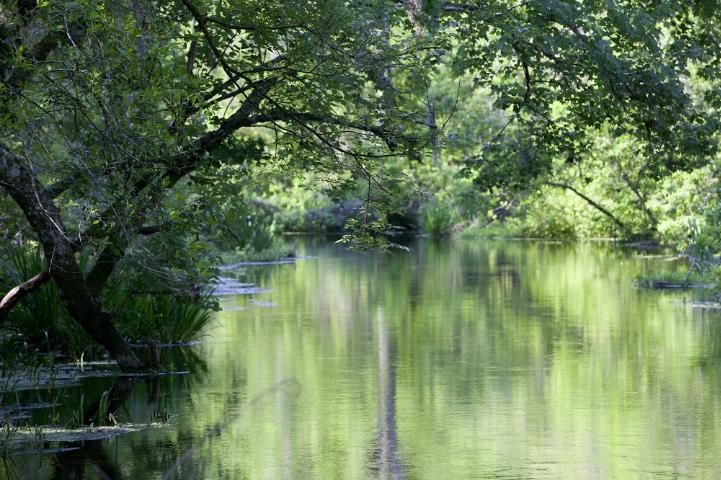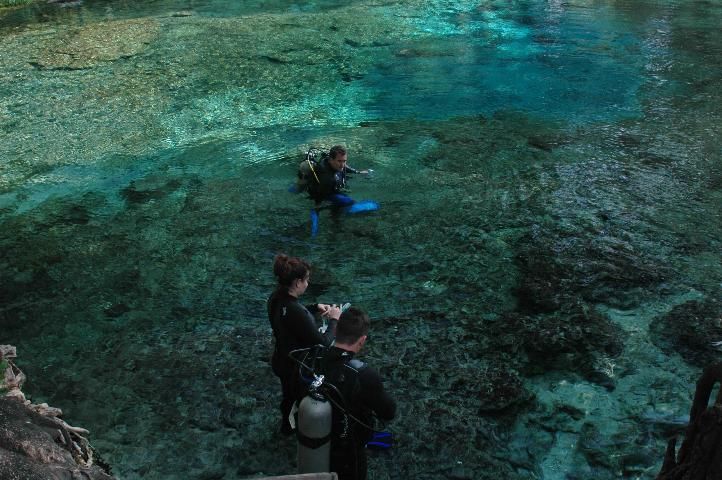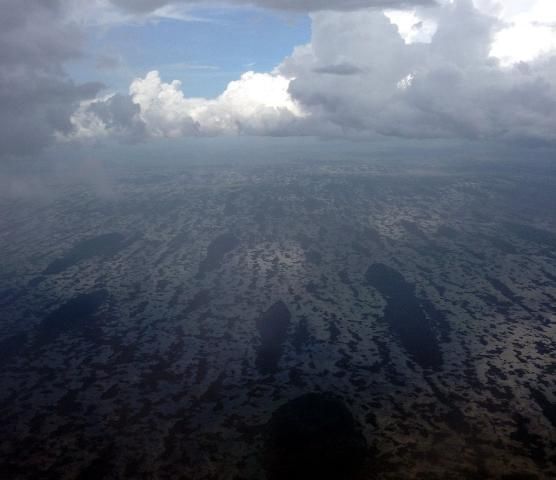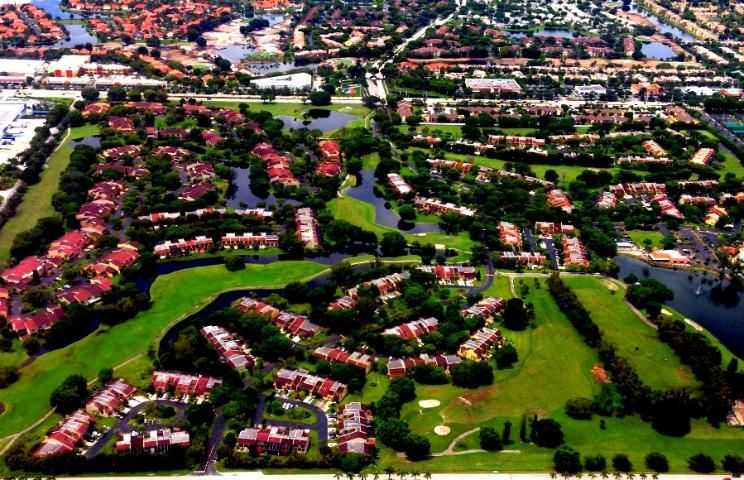Acknowledgements
This document was developed as part of a project funded by Save Our Suwannee and Florida Springs Protection Tag program, and coordinated by Stacie Greco, Alachua County Environmental Protection Department. We appreciate the helpful suggestions for this document by Dr. Damian Adams, School of Forest Resources and Conservation, and Dr. Derek Farnsworth, Food and Resource Economics Department, University of Florida.

Credit: UF/IFAS
Ecosystem Services and Why Ecosystem Service Valuation Is Important
An ecosystem is an environment in which living things—plants, insects, fungi, birds, mammals and so on—live together, cooperate, and rely on one another for their survival. Ecosystems provide a variety of benefits to people. The services ecosystems provide people can be divided into four categories (MEA 2005):
- Provisioning services: Ecosystems provide food crops, water, timber, fiber, and other raw materials humans use.
- Regulating services: Ecosystems regulate the quality of the air, water, and soil; they sequester carbon, and regulate pests and diseases.
- Cultural services: Ecosystems provide for recreation, tourism, education, and spiritual and aesthetic appreciation.
- Supporting services: Ecosystems have a variety of other processes that may not directly benefit people but are necessary for all other ecosystem services (such as nutrient cycling) (MEA 2005).
The word "value" has many meanings. Economists measure the value of ecosystem services in dollar terms to assist management decisions concerning natural resources. For example, a monetary value can help an ecosystem manager compare management plans and choose a program that generates the highest value per dollar spent. The monetary value of ecosystem services can also help decision makers justify their environmental management decisions that may require significant investments by stakeholders and the public. However, ecosystem services are not bought and sold in markets, so their economic value can only be estimated using special valuation methods.
Assigning Values to Ecosystem Services
Ecosystem services can have many different types of value (Figure 1). Use values measure the worth of direct or indirect uses of the ecosystems by people. For example, for Florida springs, swimming and snorkeling, and bottling spring water for drinking purposes are direct uses. Use value can also include the worth of the opportunity to use the system in the future. Non-use value can be "existence value" (e.g., the value derived from simply knowing that Florida has more springs with plentiful flow than any other state in the nation) or "bequest value" (e.g., the value we place on knowing that future generations can enjoy and use the springs).
![Figure 1 Figure 1. Examples of ecosystem services and their total economic value {Sources: Scottish Government (2004) and Boateng (2010)]](/image/FE959/Dvwral4ws9/D8znersxyq/D8znersxyq-2048.webp)
Credit: Scottish Government (2004); Boateng (2010)
Examples of the methods available to assign dollar values to different types of ecosystem uses include
- Total economic contributions method: This method focuses on the use values of ecosystems, for instance, by examining the economic impacts of tourism activity near a spring (Figure 2). This method analyzes direct consumer spending by non-local visitors and relates the money they spend to the flow of goods and services in the local economy, from producers, through intermediaries, to final consumers. Based on this flow of goods and services, industry production, employment, taxes, and other indicators of regional economic activity are estimated (Mulkey and Hodges 2012).
- Travel cost method: This method focuses on use values of ecosystems specifically for recreation. It is based on the assumption that the time and costs incurred by users traveling to a recreational site are the price that people are willing to pay for nature-based recreation. The total value of visitors' recreation experience is reflected in their spending levels and how many trips they make to a particular site.
- Contingent valuation method: This method can be used to measure the use and non-use values of ecosystems. The method involves using surveys and asking people to make tradeoffs between consumption of various goods and services (including ecosystem services). For example, such surveys can ask how much people would be willing to pay for water quality improvement that can result in enhanced recreational opportunities. In this case, respondents would need to compare spending money for the water quality improvement project versus spending money on something else.
- Hedonic valuation method: This method involves analyzing property sales prices to infer the value of the property amenities, such as the proximity to a lake or river of good quality.
- Benefits transfer method: This method applies information from previously completed studies on ecosystem services valuation in another location or context, adjusting for income levels, inflation, etc.

Credit: UF/IFAS
Additional information about the valuation methods for ecosystem services can be found on the Ecosystem Valuation website at https://www.ecosystemvaluation.org/1-03.htm and in Letson (2002).
What the Literature Says about the Economic Value of Florida Springs
Existing studies applied a variety of methods to assign economic values to services provided by springs and other related ecosystems (Table 1). Note that all estimates reported in this document were converted to 2014 US dollars using the Implicit Price Deflator for Gross Domestic Product (Federal Reserve Bank of St. Louis 2014).
Economic Contributions of Spring Sites to Regional Economy
Bonn and Bell (2003), Bonn (2004), and Borisova et al. (2014) examined the economic contributions of different groups of Florida springs to the regional economy. Among the spring sites assessed in the three studies, the highest direct annual consumer spending was estimated for Silver Springs ($73.89 million), Ichetucknee Springs ($28.65 million), and Wakulla Springs ($28.02 million), and employment generated by economic activity at these three spring sites was estimated at 1060, 311, and 347 jobs, respectively (Bonn 2004; Bonn and Bell 2003). Note that the economic contributions can vary from year to year.
Consumer Surplus Value of Water-Based Recreation
As stated above, the total value of recreational experiences generally exceeds visitors' total expenditures for recreational trips. Several studies used the contingent valuation method to examine consumer surplus (Huth and Morgan 2011; Morgan and Huth 2011; Shrestha et al. 2002). Note that, unlike most of the other studies listed in this document, these three studies were published in peer-reviewed journals, which increases the validity of the results. Shrestha et al. (2002) focused on water-based recreation at the Sweetwater Springs, Silver Glen Springs, Juniper Springs, and Salt Springs sites in the Ocala National Forest. The recreational experiences included boating, canoeing, swimming, fishing, and wildlife viewing activities. Estimated willingness to pay differed among day visitors and overnight (i.e., extended) visitors. Day visitors were willing to pay an average of $6.35 per visitor, per trip, given the current facilities at the spring sites. However, day visitors were willing to pay more, $11.39 per visitor trip, for moderately improved facilities (e.g., basic grocery, camping facilities, daytime tours), and $15.26 per visitor trip for greatly improved site facilities (e.g., children's play area, restaurant, rental cabins, weekend tours). In turn, for visitors who stayed overnight, willingness to pay (WTP) averages were $12.15, $16.86, and $22.72 per visitor, per trip, for different levels of improvements to spring site facilities, respectively. Based on overall visitor numbers, this amounted to a total annual WTP of about $1.30 million for current basic facilities, $2.47 million for moderately improved facilities, and $3.25 million for greatly improved facilities at the spring sites in the Ocala National Forest.
The Value of Cave Diving to Springs Visitors
Huth and Morgan (2011) and Morgan and Huth (2011) examined visitors' WTP in addition to actual expenses incurred (i.e., consumer surplus) for spring cave diving (Figure 3). For Wakulla Springs, surveyed cave divers who had previously visited the area reported a WTP ranging from $56.02 to $61.41 per dive. For Jackson Blue Springs, under the existing conditions, diver WTP was $157.30 to $179.92 per person, per trip (may include several dives). Given the total number of visitors, this represents $619,498 in annual consumer surplus for divers visiting Jackson Blue Springs, a "first magnitude" spring, with flow exceeding 100 cubic feet per second.

Credit: UF/IFAS
The Value of Freshwater-Based Recreation in the Southeastern United States
While only a few Florida-based studies examined the value of freshwater-based recreational opportunities, studies conducted in other states can also help measure the value of these ecosystem services. Loomis (2005) summarized past studies related to the value of forest-based and water-based recreation nationwide, examining consumer surplus for 30 recreational activities in five census regions of the United States. For the Southeast region, including Florida and 12 other states, the average consumer surplus values were $31.59 per person, per day for birdwatching; $94.56 for fishing; $152.16 for floatboating/rafting/canoeing; $72.72 for swimming; and $47.87 for wildlife viewing.
Willingness to Pay for Springs Water Quality Improvement
The studies discussed above focused on one category of services provided by ecosystems—recreation and tourism. However, aquatic ecosystems provide a variety of services (Figure 1), and some studies attempt to estimate the total value of these services. Foster (2008) used contingent valuation to examine Columbia County, Florida, residents' willingness to pay for water quality improvements in Ichetucknee Springs and the Ichetucknee River. Survey respondents were asked how much more they would be willing to pay in utility bills every month for the next ten years if the extra money were used to reduce nitrate pollution in the Ichetucknee River via a septic system replacement program. Reduced nitrate pollution was linked to expected ecological benefits, including improved water clarity, reduction in excessive algae growth, and protection of natural wildlife habitat. Although only 169 survey responses were collected, Foster attempted to relate the WTP to respondents' education levels, personal political beliefs, and past visitation of the Ichetucknee River. The study found a mean WTP of $18.55 per household, per month, or $221.74 per year. Combining all households in Columbia County, this amounts to $46.54 million over 10 years.
Kreyes et al. (2013) used a benefit transfer approach to estimate the value that people place on protecting water quality in unpolluted rivers and streams. The researchers conducted a review of 17 studies that examined 43 WTP measures for aquatic resource conservation in the United States. Using this data, the researchers examined the statistical relationship between the WTP estimates and the study characteristics, such as the survey method used, geographic region, water quality protection strategy, etc. The WTP estimates from these studies were applied to the state of Florida. The results demonstrate that WTP for water quality protection in Florida is high, and that WTP is very sensitive to how the water quality protection strategy is described to respondents. Florida residents' total annual WTP for programs using land acquisition or conservation easement to protect surface water was estimated at $17.93 million. For nonspecific programs or programs that do not use conservation easements or land acquisition, total WTP was $353.39 million. Specifically for the north Florida region, where many springs are located, total annual WTP for easement-type protection programs was $4.4 million, while WTP for nonspecific programs was $86.0 million.
Other Florida-based Studies of the Economic Value of Services Provided by Water Bodies
While this document focuses on economic studies related to springs, readers may be interested in other Florida-based studies of the economic value of various water bodies. Multiple studies focusing on the economic contribution to local economy of specific events and nature-based activities are available online. For example, an excellent collection of studies related to the economic contribution of trails and greenways, many of which are associated with the sites around lakes, streams, and other water bodies, is available at the website of the Office of Greenways and Trails, Florida Department of Environmental Protection (https://floridadep.gov/ogt). The Florida Division of Recreation and Parks annually assesses the economic contributions of state parks (https://floridadep.gov/lands/bureau-public-land-administration/content/faq-disposition-state-lands-and-facilities-annual). An example assessment of the economic contribution of a specific event can be found in Larkin et al. (2012). The study examines the economic impact of the 2011 State Championship of the Florida BASS Federation Nation (a chapter of the Bass Anglers Sportsman Society) at Lake Tohopekaliga (Lake Toho) in Osceola County.
Given the significant investments that are required for restoration of the Florida Everglades (Figure 4), economic studies have investigated the economic benefits associated with these restoration efforts (Milon et al. 1999; Milon and Scrogin 2006; Mather Economics 2010; Richardson 2014). Specifically, Milon et al. (1999) and Milon and Scrogin (2006) described results of a public interview survey conducted in 1998 in Miami, Fort Myers, Orlando, Tampa, and West Palm Beach to examine the values assigned by the public to the Everglades restoration plan. Alternative restoration outcomes were associated with the degree of achieving either hydrologic functions (i.e., the management of the Lake Okeechobee levels, and the Everglades National Park and Water Conservation Areas management) or ecosystem attributes (such as increases in wildlife species populations). The potential effects of the restoration plan on agricultural acreage, residential water-use restrictions, and utility taxes were also presented. The authors estimated an average household WTP of $81 per year (all currencies in 2014 US dollars) for hydrologic restoration outcomes and $96 per year for ecosystem restoration outcomes. Extrapolation of these results to the Florida population shows that the WTP for the full hydrologic restoration was $468 million annually, or $4.7 billion over a ten-year period. Note that these are maximum WTP estimates reported in the study; WTP reduced significantly when the survey presented a scenario with annual costs of $50 per household coupled with agricultural farmland reduction or severe restrictions on municipal water use restrictions. Milon and Scrogin (2006) further discussed the differences in WTP depending on respondent demographics, restoration outcomes, and costs of the restoration plans for Floridians. Note that this study was published in a peer-reviewed journal.

Credit: Tatiana Borisova, UF/IFAS
The value of water quality improvement for lakes in urban Orange County was assessed by Walsh (2009) and Walsh et al. (2010) using the hedonic valuation method to examine the relationships between the sale prices for single-family residential homes, homes' proximity to natural lakes, and the lakes' water quality (Figure 5). Specifically, sales of single-family residential properties located within 3,281 feet (1,000 meters) of one of 146 natural lakes were examined for the 1996–2004 period. Water quality in the lakes was measured using the annual mean value of Secchi Disk Measurement (SDM), an indicator of water transparency measured with a disk that is lowered into the water to a depth at which the observer can no longer see it. SDM can be linked to nutrient pollution, since nutrient load can lead to the bloom of microalgae that increases water turbidity. Walsh et al. (2010) estimated that an increase in Secchi depth (i.e., increased water clarity) by one foot results in an increase in average home sale price of about 1.2 percent ($6,900) and 0.3 percent ($880) for lakefront and non-lakefront properties, respectively.

Credit: Tatiana Borisova, UF/IFAS
Adams and Lee (2007) examined the services provided by lakes for fishing as related to the control of invasive aquatic plants in 13 of Florida's public lakes. The study used a coupled economic-hydrologic model to analyze the costs of invasive plant control and its effect on the spread of aquatic plants and on visitation to the lakes. They found that the annual net benefit of invasive plant control in the 13 lakes is $75 million.
Interested readers can also find other reports developed by federal and state agencies and other organizations related to proposed water quality regulations (e.g., USEPA 2010; National Research Council 2012). Finally, for the analysis of the value of water in agricultural production, see studies by de Bodisco (2007), Moss and Schmitz (2013), and Schmitz et al. (2012).
Conclusions
Overall, the existing studies illustrate the high value Florida residents and visitors place on aquatic natural resources. And as the nine studies reviewed here demonstrate, Florida's springs have a very large economic value, both for recreation and resource conservation. Willingness to pay studies show that people who benefit from Florida springs place a high value on them. Economic contribution studies show that Florida springs play a significant role in local and state economic health and job creation.
References
Adams, D.C. and D.J. Lee. 2007. Estimating the value of invasive aquatic plant control: A bioeconomic analysis of 13 public lakes in Florida. Journal of Agricultural and Applied Economics 39:97–109. https://doi.org/10.1017/S1074070800028972
Boateng, I. (ed.) 2010. Spatial Planning in Coastal Regions: Facing the Impact of Climate Change. FIG Publication 55. FIG Commission 8 Working Group 8.4, International Federation of Surveyors (FIG), Copenhagen, Denmark. https://www.fig.net/resources/publications/figpub/pub55/figpub55.asp
Bonn, M.A. and F.W. Bell. 2003. Economic impact of selected Florida springs on surrounding local areas. Florida Department of Environmental Protection, Tallahassee, FL. http://www.dep.state.fl.us/springs/reports/files/EconomicImpactStudy.doc
Bonn, M.A. 2004. Visitor profiles, economic impacts, and recreational aesthetic values associated with eight priority Florida springs located in the St. Johns River Water Management District. St. Johns River Water Management District, Palatka, FL. http://www.dep.state.fl.us/parks/planning/ssag/Mark%20Bonn%20Springs%20Study%202004.pdf
Borisova, T., A.W. Hodges, and T.J. Stevens. 2014. Economic Contributions and Ecosystem Services of Springs in the Lower Suwannee and Santa Fe River Basins of North-Central Florida. Report for Save Our Suwannee, Inc., Wildlife Foundation of Florida, and Alachua County, Florida. https://fred.ifas.ufl.edu/pdf/economic-impact-analysis/Springs_Economic_Report_6-4-14.pdf
de Bodisco, C. 2007. The regional value of water in agriculture. Ph.D. dissertation, Vanderbilt University, Nashville, TN. https://etd.library.vanderbilt.edu/etd-07242007-003333
Federal Reserve Bank of St. Louis. 2014. Gross domestic product: Implicit price deflator. Federal Reserve Bank of St. Louis, St. Louis, MO. https://fred.stlouisfed.org/series/GDPDEF/
Foster, C. 2008. Valuing preferences for water quality improvement in the Ichetucknee Springs System: A case study from Columbia County, FL. Master's thesis, University of Florida. https://ufdc.ufl.edu/UFE0022388/00001/pdf
Huth, W.L. and O.A. Morgan. 2011. Measuring the willingness to pay for cave diving. Marine Resource Economics 26:151–166. https://doi.org/10.5950/0738-1360-26.2.151
Kreye, M., F.J. Escobedo, D.C. Adams, T. Stein, T. Borisova. 2013. Valuing the ecosystem services of Florida's forest conservation programs: The economic benefits of protecting water quality. #FR377. UF/IFAS Extension. https://doi.org/10.32473/edis-fr377-2013
Larkin, S., J. Georges, A. Hodges, M. Allen, and D. Jones. 2012. The economic impact of the 2011 Florida BASS Federation Tournament to Osceola County and the event's economic value to participants. #FE916. UF/IFAS Extension. https://doi.org/10.32473/edis-fe916-2012
Letson, D. 2002. "Principles of economic valuation." In: Florida Coastal Environmental Resources: A Guide to Economic Valuation and Impact Analysis, edited by D. Letson and J. W. Milon. Gainesville, FL: Florida Sea Grant College Program.
Loomis, J. 2005. Updated Outdoor Recreation Use Values on National Forests and Other Public Lands. Forest Service General Technical Report, United States Department of Agriculture, Washington, D.C. https://doi.org/10.2737/PNW-GTR-658
Mather Economics. 2010. Measuring the Economic Benefits of America's Everglades Restoration. Report commissioned by the Everglades Foundation.
Millennium Ecosystem Assessment (MEA) Board. 2005. Ecosystems and human well-being: Synthesis. https://www.millenniumassessment.org/documents/document.356.aspx.pdf
Milon, J. W., A. W. Hodges, A, Rimal, C .F. Kiker, and F. Casey. 1999. Public Preferences and Economic Values for Restoration of the Everglades/South Florida Ecosystem. Economics Report 99-1, Food and Resource Economics Department, University of Florida, Gainesville, FL. https://fred.ifas.ufl.edu/pdf/economic-impact-analysis/er99-1.pdf
Milon, J.W. and D. Scrogin. 2006. Latent preferences and valuation of wetland ecosystem restoration. Ecological Economics 56(2):162–175. https://doi.org/10.1016/j.ecolecon.2005.01.009
Morgan A.O. and W.L. Huth. 2011. Using revealed and stated preference data to estimate the scope and access benefits associated with cave diving. Resource and Energy Economics 33:107–118. https://doi.org/10.1016/j.reseneeco.2010.01.005
Moss, C.B. and A. Scmitz. 2013. Positive and negative externalities in agricultural production: The case of Adena Springs Ranch. Journal of Agricultural and Applied Economics 45(3):401–409. https://doi.org/10.1017/S1074070800004934[MR3]
Mulkey, D. and A.W. Hodges. 2012. Using Implan to assess local economic impacts. FE168. UF/IFAS Extension. https://edis.ifas.ufl.edu/fe168
National Research Council. 2012. Review of the EPA's Economic Analysis of Final Water Quality Standards for Lakes and Flowing Waters in Florida. National Research Council, Washington, D.C. https://nap.nationalacademies.org/catalog/13376/review-of-the-epas-economic-analysis-of-final-water-quality-standards-for-nutrients-for-lakes-and-flowing-waters-in-florida
Richardson, L. 2014. Ecosystem Service Valuation of Everglades Restoration. USGS Research Task RB00CMF.2.1. United States Geological Survey, Reston, VA.
Schmitz, A., P.L. Kennedy, and J. Hill-Gabriel. 2012. Restoring the Florida Everglades through a sugar land buyout: benefits, costs, and legal challenges. Environmental Economics 3(1):74–89. https://www.businessperspectives.org/images/pdf/applications/publishing/templates/article/assets/4572/ee_2012_01_Schmitz.pdf
Scottish Government. 2004. An Economic Assessment of the Costs and Benefits of Natura 2000 Sites in Scotland. Final Report, Scottish Executive 2004, Environment Group Research Report 2004/05. https://www.webarchive.org.uk/wayback/archive/20150220214527/http://www.gov.scot/Publications/2004/06/19426/38109
Shrestha, R.L., J.R.R. Alavalapati, T.V. Stein., D.R. Carter, and C.B. Denny. 2002. Visitor preferences and values for water-based recreation: A case study of the Ocala National Forest. Journal of Agricultural and Applied Economics 34(3):547–559. https://doi.org/10.1017/S1074070800009305
USEPA (United States Environmental Protection Agency). 2010. Economic Analysis of Final Water Quality Standards for Nutrients for Lakes and Flowing Waters in Florida. Office of Water, Office of Science and Technology, United States Environmental Protection Agency, Washington, D.C. 20460. https://www.lake.wateratlas.usf.edu/upload/documents/florida_econ.pdf
Walsh P., W. Milon, and D. Scrogin. 2010. The spatial extent of water quality benefits in urban housing markets. Working Paper #10-02. National Center for Environmental Economics, United States Environmental Protection Agency, Washington, D.C. https://www.epa.gov/sites/default/files/2014-12/documents/spatial_extent_of_water_quality_benefits.pdf
Walsh, P. 2009. Hedonic property value modeling of water quality, lake proximity, and spatial dependence in Central Florida. PhD dissertation, Department of Economics, The University of Central Florida, Orlando, FL. https://stars.library.ucf.edu/cgi/viewcontent.cgi?article=4856&context=etd